Stephen E. Braddock's Ireland Diary
I started the day at 6:00am in bright clear sunshine and 60 degrees Fahrenheit. First stop was an early appointment with an Immigration Officer at the Irish Naturalisation & Immigration Service which is headquartered along the River Liffey, just a short walk from Trinity. After a brief interview the officer determined that I, as one with dual Irish and U.S. citizenship, was qualified to be given an official Without Conditions Endorsement placed in my non-Irish (U.S.A.) passport. This endorsement stamp certifies that I am permitted to remain in Ireland without condition. As a naturalized citizen (dual-nationality) I can now use my non-Irish passport for certain trips when re-entering Ireland with that passport and without any conditions or restrictions. The endorsement is said to be handy when travelling on an original passport & re-entering Ireland.
The HISTORIC POST OFFICE was my next stop.
The Proclamation of the Republic (Irish: Forógra na Poblachta), also known as the 1916 Proclamation or the Easter Proclamation, was a document issued by the Irish Volunteers and the Irish Citizen Army during the Easter Rising in Ireland, which began on 24 April 1916.
The Proclamation was read outside of the General Post Office in Dublin and marked the beginning of the Rising. In it, the Military Council of the Irish Republican Brotherhood, styling itself the "Provisional Government of the Irish Republic", proclaimed Ireland's independence from the United Kingdom. During this time in 1916, my grandfather was fighting with his battalion throughout areas in and around Galway.
Full copies of the Easter Proclamation are now treated as a revered Irish national icon, and a copy was sold at auction for €390,000 in December 2004. Copies are on display in the General Post Office (headquarters of the Rising and the place where the Proclamation was first read), the National Museum of Ireland, the Trinity College Library's Long Room and other museums worldwide. Facsimile copies are sold as souvenirs in Ireland, and copies of the text are often displayed in Irish schools and in Irish pubs throughout the world. The proclamation is read aloud by an Officer of the Irish Defense Forces outside the GPO during the Easter Rising commemorations on Easter Sunday of each year.
This is the full text of the Proclamation that my grandfather and other ancestors risked their lives for:
POBLACHT NA hÉIREANN
THE PROVISIONAL GOVERNMENT OF THE IRISH REPUBLIC TO THE PEOPLE OF IRELAND
IRISHMEN AND IRISHWOMEN:
In the name of God and of the dead generations from which she receives her old tradition of nationhood, Ireland, through us, summons her children to her flag and strikes for her freedom.
Having organised and trained her manhood through her secret revolutionary organisation, the Irish Republican Brotherhood, and through her open military organisations, the Irish Volunteers and the Irish Citizen Army, having patiently perfected her discipline, having resolutely waited for the right moment to reveal itself, she now seizes that moment, and supported by her exiled children in America and by gallant allies in Europe, but relying in the first on her own strength, she strikes in full confidence of victory.
We declare the right of the people of Ireland to the ownership of Ireland and to the unfettered control of Irish destinies, to be sovereign and indefeasible. The long usurpation of that right by a foreign people and government has not extinguished the right, nor can it ever be extinguished except by the destruction of the Irish people. In every generation the Irish people have asserted their right to national freedom and sovereignty; six times during the past three hundred years they have asserted it in arms. Standing on that fundamental right and again asserting it in arms in the face of the world, we hereby proclaim the Irish Republic as a Sovereign Independent State, and we pledge our lives and the lives of our comrades in arms to the cause of its freedom, of its welfare, and of its exaltation among the nations.
The Irish Republic is entitled to, and hereby claims, the allegiance of every Irishman and Irishwoman. The Republic guarantees religious and civil liberty, equal rights and equal opportunities to all its citizens, and declares its resolve to pursue the happiness and prosperity of the whole nation and of all its parts, cherishing all the children of the nation equally, and oblivious of the differences carefully fostered by an alien Government, which have divided a minority from the majority in the past.
Until our arms have brought the opportune moment for the establishment of a permanent National Government, representative of the whole people of Ireland and elected by the suffrages of all her men and women, the Provisional Government, hereby constituted, will administer the civil and military affairs of the Republic in trust for the people.
We place the cause of the Irish Republic under the protection of the Most High God, Whose blessing we invoke upon our arms, and we pray that no one who serves that cause will dishonour it by cowardice, inhumanity, or rapine. In this supreme hour the Irish nation must, by its valour and discipline, and by the readiness of its children to sacrifice themselves for the common good, prove itself worthy of the august destiny to which it is called.
Signed on behalf of the Provisional Government:
THOMAS J. CLARKE
SEAN Mac DIARMADA
P. H. PEARSE
JAMES CONNOLLY
THOMAS MacDONAGH
EAMONN CEANNT
JOSEPH PLUNKETT
frbraddock
23 chapters
16 Apr 2020
Day 2: Dublin
August 09, 2018
|
Dublin City Centre
I started the day at 6:00am in bright clear sunshine and 60 degrees Fahrenheit. First stop was an early appointment with an Immigration Officer at the Irish Naturalisation & Immigration Service which is headquartered along the River Liffey, just a short walk from Trinity. After a brief interview the officer determined that I, as one with dual Irish and U.S. citizenship, was qualified to be given an official Without Conditions Endorsement placed in my non-Irish (U.S.A.) passport. This endorsement stamp certifies that I am permitted to remain in Ireland without condition. As a naturalized citizen (dual-nationality) I can now use my non-Irish passport for certain trips when re-entering Ireland with that passport and without any conditions or restrictions. The endorsement is said to be handy when travelling on an original passport & re-entering Ireland.
The HISTORIC POST OFFICE was my next stop.
The Proclamation of the Republic (Irish: Forógra na Poblachta), also known as the 1916 Proclamation or the Easter Proclamation, was a document issued by the Irish Volunteers and the Irish Citizen Army during the Easter Rising in Ireland, which began on 24 April 1916.
The Proclamation was read outside of the General Post Office in Dublin and marked the beginning of the Rising. In it, the Military Council of the Irish Republican Brotherhood, styling itself the "Provisional Government of the Irish Republic", proclaimed Ireland's independence from the United Kingdom. During this time in 1916, my grandfather was fighting with his battalion throughout areas in and around Galway.
Full copies of the Easter Proclamation are now treated as a revered Irish national icon, and a copy was sold at auction for €390,000 in December 2004. Copies are on display in the General Post Office (headquarters of the Rising and the place where the Proclamation was first read), the National Museum of Ireland, the Trinity College Library's Long Room and other museums worldwide. Facsimile copies are sold as souvenirs in Ireland, and copies of the text are often displayed in Irish schools and in Irish pubs throughout the world. The proclamation is read aloud by an Officer of the Irish Defense Forces outside the GPO during the Easter Rising commemorations on Easter Sunday of each year.
This is the full text of the Proclamation that my grandfather and other ancestors risked their lives for:
POBLACHT NA hÉIREANN
THE PROVISIONAL GOVERNMENT OF THE IRISH REPUBLIC TO THE PEOPLE OF IRELAND
IRISHMEN AND IRISHWOMEN:
In the name of God and of the dead generations from which she receives her old tradition of nationhood, Ireland, through us, summons her children to her flag and strikes for her freedom.
Having organised and trained her manhood through her secret revolutionary organisation, the Irish Republican Brotherhood, and through her open military organisations, the Irish Volunteers and the Irish Citizen Army, having patiently perfected her discipline, having resolutely waited for the right moment to reveal itself, she now seizes that moment, and supported by her exiled children in America and by gallant allies in Europe, but relying in the first on her own strength, she strikes in full confidence of victory.
We declare the right of the people of Ireland to the ownership of Ireland and to the unfettered control of Irish destinies, to be sovereign and indefeasible. The long usurpation of that right by a foreign people and government has not extinguished the right, nor can it ever be extinguished except by the destruction of the Irish people. In every generation the Irish people have asserted their right to national freedom and sovereignty; six times during the past three hundred years they have asserted it in arms. Standing on that fundamental right and again asserting it in arms in the face of the world, we hereby proclaim the Irish Republic as a Sovereign Independent State, and we pledge our lives and the lives of our comrades in arms to the cause of its freedom, of its welfare, and of its exaltation among the nations.
The Irish Republic is entitled to, and hereby claims, the allegiance of every Irishman and Irishwoman. The Republic guarantees religious and civil liberty, equal rights and equal opportunities to all its citizens, and declares its resolve to pursue the happiness and prosperity of the whole nation and of all its parts, cherishing all the children of the nation equally, and oblivious of the differences carefully fostered by an alien Government, which have divided a minority from the majority in the past.
Until our arms have brought the opportune moment for the establishment of a permanent National Government, representative of the whole people of Ireland and elected by the suffrages of all her men and women, the Provisional Government, hereby constituted, will administer the civil and military affairs of the Republic in trust for the people.
We place the cause of the Irish Republic under the protection of the Most High God, Whose blessing we invoke upon our arms, and we pray that no one who serves that cause will dishonour it by cowardice, inhumanity, or rapine. In this supreme hour the Irish nation must, by its valour and discipline, and by the readiness of its children to sacrifice themselves for the common good, prove itself worthy of the august destiny to which it is called.
Signed on behalf of the Provisional Government:
THOMAS J. CLARKE
SEAN Mac DIARMADA
P. H. PEARSE
JAMES CONNOLLY
THOMAS MacDONAGH
EAMONN CEANNT
JOSEPH PLUNKETT
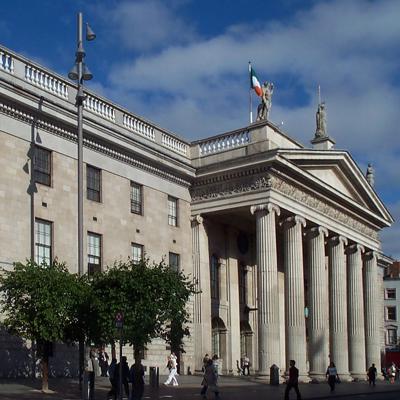
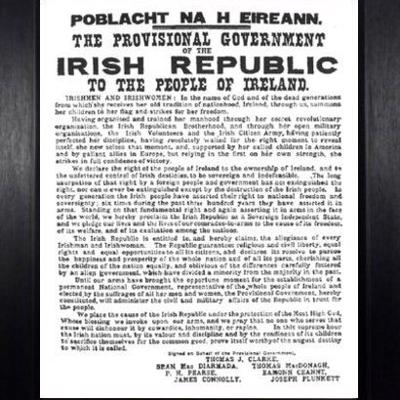
Famine Memorial & Emigration
No event in history has had a more profound effect on Ireland and the worldwide Irish Community than that of the Great Irish Famine (1845-1849). The Famine statues, in Custom House Quay in the Dublin Docklands, were presented to the City of Dublin in 1997.
These statues commemorate the Great Famine of the mid-19th century. During the famine approximately 1 million people died and a million more emigrated from Ireland, causing the island's population to fall by between 20% and 25%. Although blight ravaged potato crops throughout Europe during the 1840s, the impact and human cost in Ireland, where one third of the population was entirely dependent on the potato for food, was exacerbated by a host of political, social and economic factors.
Ireland is the one place around the world that has a lower population today than it did in the mid-19th century. The migration, the exodus, continued from that point forward. In the 1855 New York census, 25% of the population of Manhattan were Irish born.
I watched a documentary on Amazon last week called “Out of Ireland”, narrated by my old Key West friend, actress Kelly McGillis. It is well worth the $1.99 to rent it, especially if you are a descendant of emigrants. I was surprised to learn, among many things, that less than 10% of Irish immigrants have returned since the start of mass
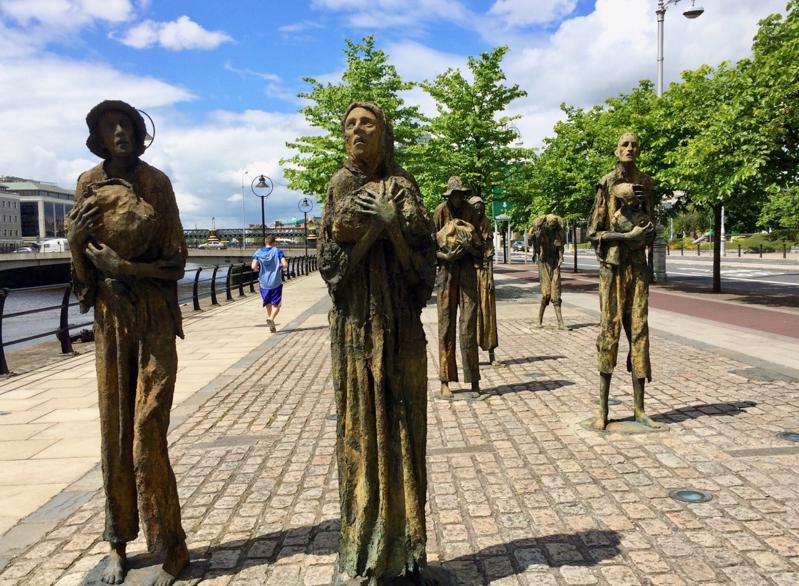
emigration to the present day. This is far, far less than experienced in other countries. It is said that Ireland’s most valuable export is its own people.
The Irish brought little with them materially but brought a hunger for freedom and independence. I’ve come to understand that emigrants like my grandparents, did not see themselves going to a foreign land, but to a land they wanted Ireland to ultimately become.
My grandparents both emigrated in 1927 in search of brighter futures. And, my grandfather had a price on his head for years. My grandmother, Nora Bridget Devins (b. 11/22/1904 – d. 12/22/1968), journeyed aboard the SS Cedric on 10/08/27; and my grandfather, Peter Benedict Clarke (b. 08/19/1900 – d. 12/12/1977), aboard the SS Celtic on 03/23/27. I’m glad they lived to see a free, if not yet prosperous and united Ireland. They found each other in America and married in 1935 giving birth to my Mom, Nonnie (Gaelic for Nora), in 1940. My Mom brought me into the world in July 1964 and my grandmother died at Christmastime 1968 after delivering holiday food baskets to poor families in New York. No doubt the Great Famine shaped the way my grandparents saw the plight of the poor and why they struggled on behalf of marginalized people.
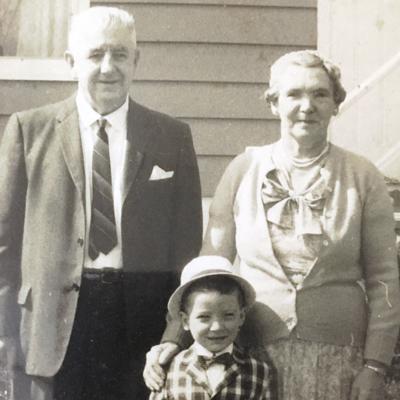
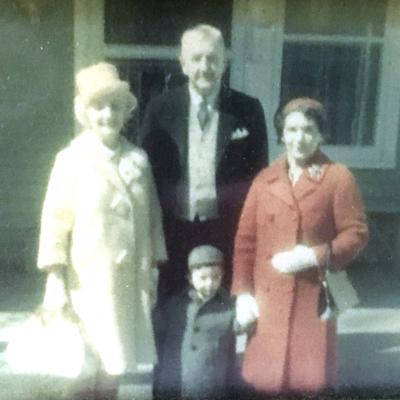
I paid a visit to the Famine Memorial & The Human Rights and Poverty Stone, which is a commemorative stone to mark International Day for the Eradication of Poverty. The stone is situated near the Famine Memorial. On the other side of the memorial, a homeless man "sleeps rough" in the shadow of the historic Customs House. In March 2018, the official rough sleeping count confirmed 110 people sleeping rough in Dublin. Almost 7,000 people are homeless in Ireland according to folks I spoke with at St. Vincent de Paul.
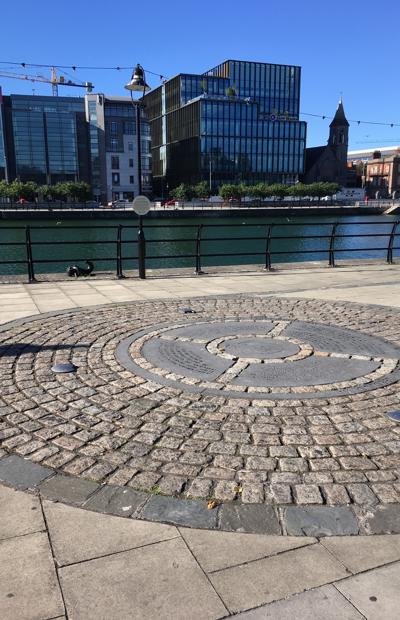
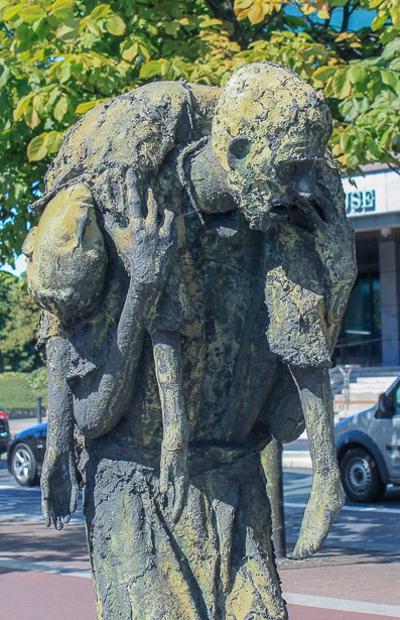
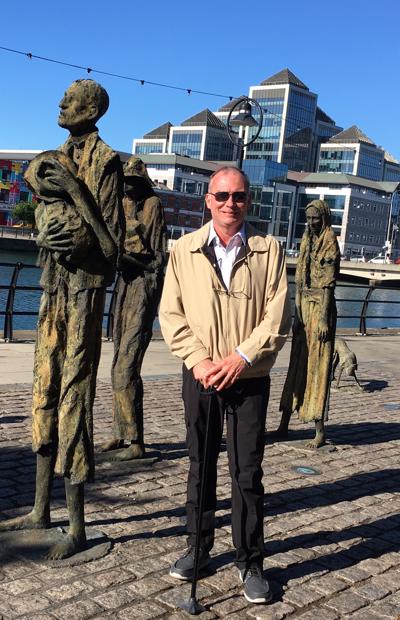
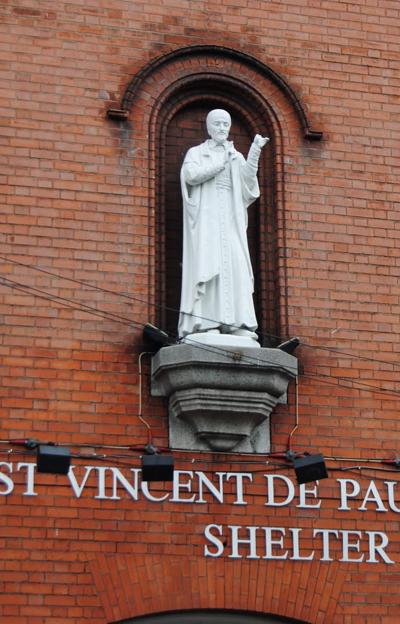
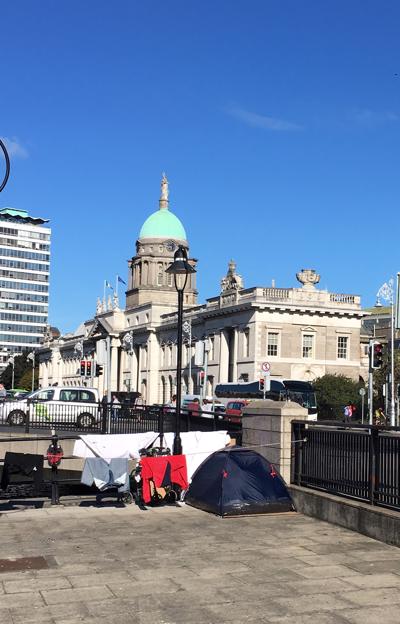
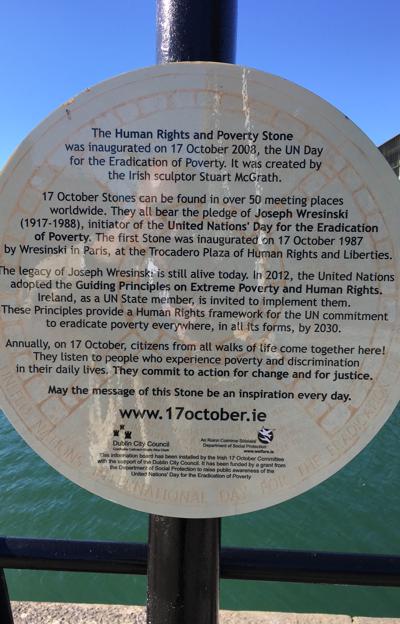
St Stephen’s Green Park is a historical park and garden, located in the centre of Dublin city a short walk from Trinity.
The park is an important public resource in the area, and provides an oasis of green calm in the middle of a bustling city.
Its four centuries of history are eventful and complex, involving such important figures as Arthur Guinness. The park hosts a large number of important sculptural monuments to Irish history.
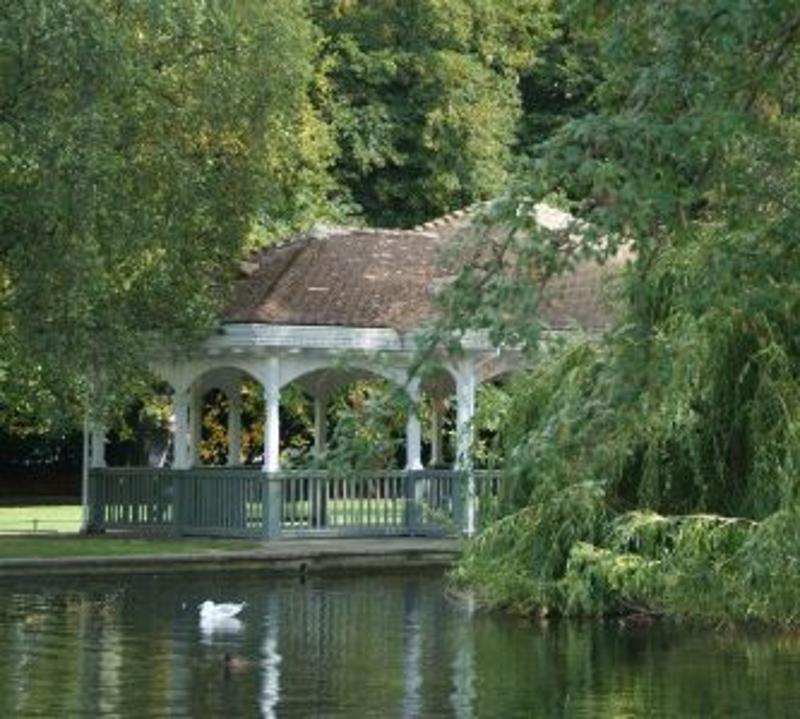
Saint Patrick's Cathedral, founded in 1191, is the National Cathedral of the Church of Ireland. With its 43-metre (141 ft) spire, St. Patrick's is the tallest church (not Cathedral) in Ireland and the largest.
Christ Church Cathedral (or, more formally, The Cathedral of the Holy Trinity) is the cathedral of the United Dioceses of Dublin and Glendalough and the cathedral of the Ecclesiastical province of the United Provinces of Dublin and Cashel in the Church of Ireland. It is the elder of the capital city's two medieval cathedrals, the other being St Patrick's Cathedral.
St Mary's Church, known also as St Mary's Pro-Cathedral or simply the Pro-Cathedral, the Chapel in Marlborough Street or the Pro, is a pro-cathedral and is the episcopal seat of the Roman Catholic Archbishop of Dublin and Primate of Ireland.
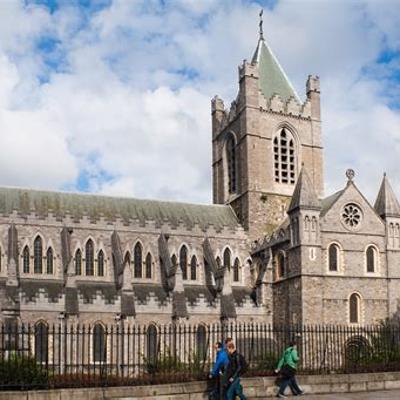
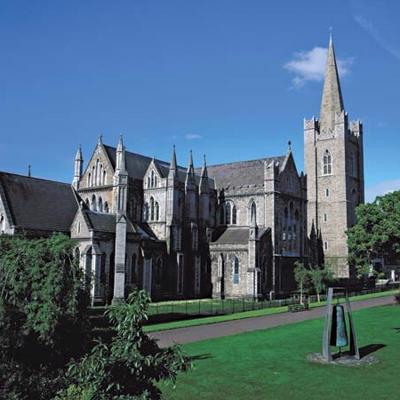
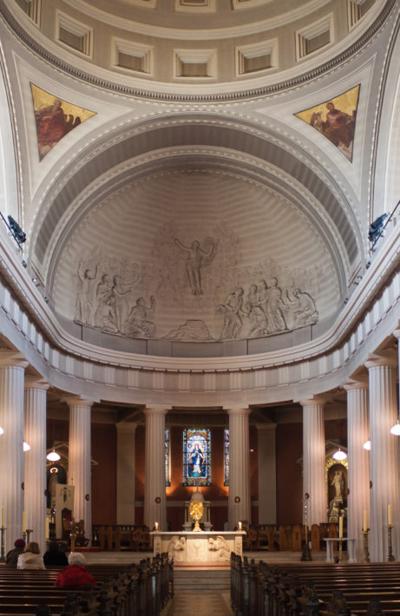
1.
Off to the Emerald Isle!
2.
Day 1: Dublin
3.
Day 2: Dublin
4.
Day 3: Dublin
5.
Day 4: Rosslare Harbour
6.
Day 5: Kinsale
7.
Day 6: Kinsale Part Two
8.
Day 7: The Wild Atlantic Way Begins...
9.
Day 8: The Wild Atlantic Way to Killarney
10.
Day 9: Tralee
11.
Day 10: Tarbert
12.
Day 11: Loop Head
13.
Day 12: Ballinasloe, Clarke Family History, & Knock Shrine
14.
Day 13: Galway City
15.
Day 14: Ballyvaughan - The Burren, County Clare
16.
Day 15: Cliffs of Moher. ALONE!!!
17.
Day 16: Connemara & Sligo
18.
Day 17: Sligo and Great Grandparents Devins
19.
Day 18: Roscommon & Athlone
20.
Day 19: Kildare, County Kildare & Dublin City
21.
Day 20: Mountjoy Prison, Dublin
22.
Day 21: Erin Go Bragh!
23.
Notes: Places I'd Stay Again
Share your travel adventures like this!
Create your own travel blog in one step
Share with friends and family to follow your journey
Easy set up, no technical knowledge needed and unlimited storage!